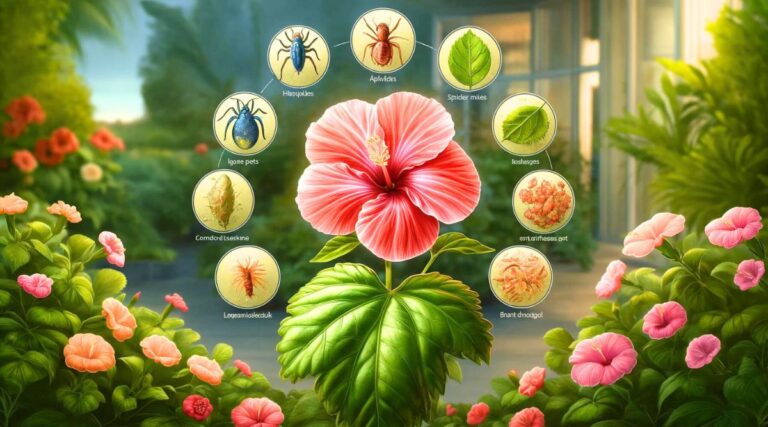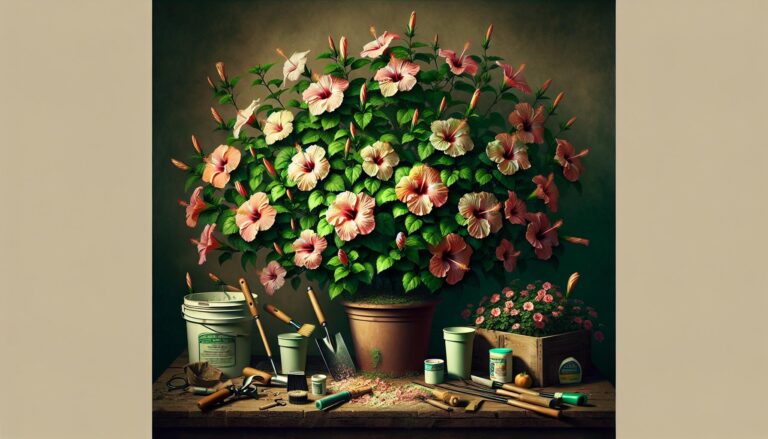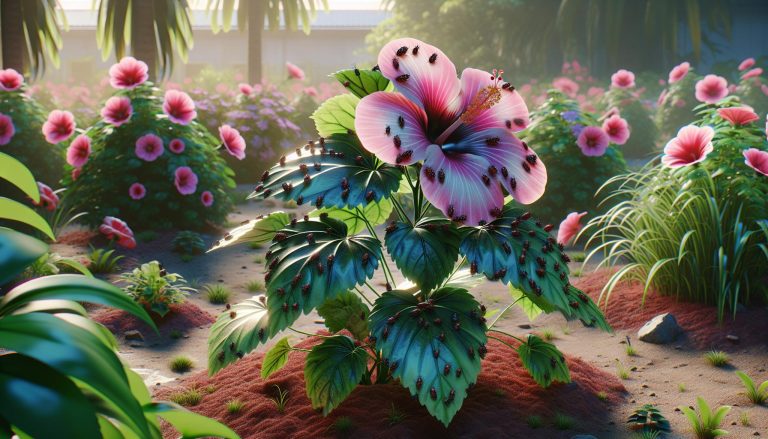Why Your Hibiscus Isn’t Flowering: 7 Common Reasons and Solutions
Are you struggling with a hibiscus plant that refuses to bloom? I’ve been there, and I know how frustrating it can be to nurture a plant only to have it withhold its beautiful flowers. Hibiscus plants are renowned for their stunning, vibrant blooms, but sometimes they just won’t cooperate.
There are several reasons why your hibiscus might not be flowering. From improper lighting and watering to nutrient deficiencies and pruning mistakes, the culprits can be numerous. But don’t worry – I’ve got you covered. In this article, I’ll share my experience and knowledge to help you identify the problem and get your hibiscus blooming again. Ready to transform your reluctant plant into a flowering showstopper?
Understanding Hibiscus Flowering Habits
Hibiscus plants are renowned for their stunning blooms, but their flowering habits can vary significantly. I’ll explore the different types of hibiscus and their typical blooming seasons to help you better understand your plant’s behavior.
Types of Hibiscus Plants
Hibiscus plants come in three main categories: tropical, hardy, and rose of Sharon. Tropical hibiscus (Hibiscus rosa-sinensis) boasts large, colorful flowers and thrives in warm climates. Hardy hibiscus (Hibiscus moscheutos) withstands colder temperatures and produces dinner plate-sized blooms. Rose of Sharon (Hibiscus syriacus) is a deciduous shrub with smaller flowers that bloom later in the season.
Typical Blooming Seasons
Blooming seasons for hibiscus plants vary based on their type and climate:
- Tropical hibiscus: Flowers year-round in warm climates; blooms from late spring to early fall in cooler regions
- Hardy hibiscus: Blooms from mid-summer to early fall
- Rose of Sharon: Flowers from mid-summer through early fall
Factors like temperature, daylight hours, and growing conditions influence the exact timing and duration of hibiscus blooming periods. Understanding these patterns helps set realistic expectations for your hibiscus plant’s flowering performance.
Common Reasons for Hibiscus Not Flowering
Hibiscus plants may fail to bloom due to several factors. Understanding these common reasons can help identify and address issues preventing your hibiscus from flowering.
Improper Sunlight Exposure
Inadequate sunlight is a primary cause of non-flowering hibiscus. These plants require 6-8 hours of direct sunlight daily for optimal blooming. Insufficient light leads to weak growth and reduced flower production. Conversely, excessive sunlight in hot climates can stress the plant, causing bud drop or failure to form buds.
Inadequate Watering Practices
Incorrect watering significantly impacts hibiscus flowering. Overwatering causes root rot, while underwatering leads to drought stress. Both conditions inhibit flower production. Hibiscus plants need consistently moist soil, not waterlogged or bone-dry. Water deeply when the top inch of soil feels dry, ensuring proper drainage to prevent waterlogging.
Nutrient Deficiencies
Lack of essential nutrients often results in poor hibiscus flowering. Nitrogen, phosphorus, and potassium are crucial for healthy growth and abundant blooms. Yellowing leaves indicate nitrogen deficiency, while phosphorus deficiency causes stunted growth and reduced flowering. Use a balanced, slow-release fertilizer specifically formulated for hibiscus during the growing season to address nutrient needs.
Pruning Mistakes
Improper pruning techniques can significantly reduce hibiscus flowering. Pruning at the wrong time or too severely removes potential flowering buds. For tropical hibiscus, prune in early spring before new growth begins. Hardy hibiscus benefits from late winter or early spring pruning. Avoid heavy pruning during the active growing season, as it redirects energy from flower production to new growth.
Environmental Factors Affecting Hibiscus Blooms
Environmental factors play a crucial role in hibiscus flowering. Understanding and managing these elements is key to promoting abundant blooms in your hibiscus plants.
Temperature Fluctuations
Temperature fluctuations significantly impact hibiscus blooming. Tropical hibiscus thrives in temperatures between 60°F and 90°F (15°C to 32°C). Exposure to temperatures below 50°F (10°C) or above 95°F (35°C) for extended periods can stress the plant, leading to reduced flowering or bud drop. Hardy hibiscus varieties tolerate cooler temperatures but still require warmth to initiate blooming. To protect your hibiscus from extreme temperatures:
- Move potted plants indoors during cold spells
- Provide shade during intense heat waves
- Use mulch to insulate roots and maintain soil temperature
Humidity Levels
Hibiscus plants prefer moderate to high humidity levels for optimal flowering. Tropical varieties thrive in humidity ranges of 60-80%, while hardy hibiscus can tolerate slightly lower levels. Low humidity can cause bud drop and hinder flower development. To maintain appropriate humidity:
- Mist the leaves regularly during dry periods
- Group plants together to create a microclimate
- Use a humidity tray filled with pebbles and water
- Run a humidifier near indoor plants during winter months
Monitoring and adjusting these environmental factors will help create ideal conditions for your hibiscus to produce vibrant, long-lasting blooms.
Pest and Disease Issues Preventing Flowering
Pest infestations and diseases can significantly impact a hibiscus plant’s ability to produce flowers. These issues stress the plant, diverting its energy from bloom production to survival and recovery. Let’s explore the common pests and diseases that can hinder hibiscus flowering.
Common Hibiscus Pests
Hibiscus plants are susceptible to various pests that can interfere with their flowering process. Here are some of the most common culprits:
- Aphids: These tiny insects cluster on new growth, sucking sap and weakening the plant.
- Spider mites: Microscopic arachnids that cause stippling on leaves and weaken the plant’s overall health.
- Whiteflies: Small, white flying insects that feed on plant sap and excrete honeydew, promoting sooty mold growth.
- Mealybugs: Cotton-like pests that suck plant juices and secrete honeydew, attracting ants and promoting fungal growth.
- Thrips: Tiny insects that damage flower buds and leaves, causing distorted growth and reduced flowering.
To combat these pests, I regularly inspect my hibiscus plants and use insecticidal soap or neem oil for treatment. For severe infestations, I consider using systemic insecticides as a last resort.
Diseases That Affect Bloom Production
Several diseases can impact hibiscus health and flowering. Here are some common issues:
- Root rot: Caused by overwatering or poor drainage, leading to wilting and reduced flowering.
- Leaf spot: Fungal disease causing dark spots on leaves, potentially leading to defoliation and reduced plant vigor.
- Botrytis blight: Gray mold that affects flower buds, preventing them from opening.
- Hibiscus chlorotic ringspot virus: Causes yellowing and stunted growth, reducing overall plant health and flower production.
- Verticillium wilt: Soil-borne fungal disease that causes wilting and yellowing of leaves, ultimately affecting flower production.
To prevent these diseases, I ensure proper watering practices, maintain good air circulation, and promptly remove infected plant parts. For fungal issues, I apply appropriate fungicides when necessary. By addressing pest and disease problems promptly, I help my hibiscus plants focus their energy on producing beautiful blooms.
Encouraging Hibiscus to Flower
To promote hibiscus flowering, I’ll focus on three key areas: proper fertilization, optimal watering, and strategic pruning. These techniques work together to create ideal conditions for hibiscus plants to produce abundant blooms.
Proper Fertilization Techniques
Hibiscus plants thrive with balanced nutrition. I apply a fertilizer with a ratio of 5-10-5 or 10-10-10 every 2-3 weeks during the growing season. Slow-release fertilizers work well, providing a steady supply of nutrients. I avoid high-nitrogen fertilizers, as they promote leaf growth at the expense of flowers. Phosphorus-rich fertilizers encourage bud development and flowering.
Optimal Watering Methods
Consistent moisture is crucial for hibiscus flowering. I water deeply when the top inch of soil feels dry, ensuring the water reaches the roots. Hibiscus plants prefer moist but not waterlogged soil. I use a drip irrigation system or soaker hose to deliver water directly to the root zone, avoiding wet foliage. During hot periods, I water more frequently, adjusting based on weather conditions and soil type.
Strategic Pruning Approaches
Pruning hibiscus correctly stimulates new growth and flower production. I prune in early spring before new growth begins, removing dead, damaged, or crossing branches. For hardy hibiscus, I cut back the entire plant to 4-6 inches above the ground. With tropical hibiscus, I trim 1/3 of the plant’s height, focusing on shaping and encouraging bushy growth. I avoid heavy pruning during the flowering season to prevent removing potential blooms.
Conclusion
Nurturing a hibiscus to bloom requires attention to various factors. By addressing lighting, watering, nutrition, pruning, and environmental conditions, you’ll set the stage for vibrant flowers. Don’t forget to keep an eye out for pests and diseases that can hinder blooming. With proper care and patience, you’ll be rewarded with stunning hibiscus blooms that’ll transform your garden or indoor space. Remember, each hibiscus variety has unique needs, so tailor your approach accordingly. Happy gardening!







